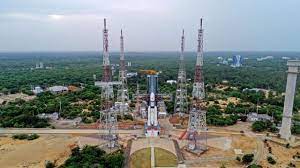Election Year Not A Problem: India’s Fiscal Restraint Impresses IMF
The Indian economy is performing well and remains the world’s bright spot, according to the International Monetary Fund, which praised India for maintaining budgetary restraint in an election year.

“The Indian economy is performing nicely right now. 6.8% growth is an excellent rate of growth. There is a decline in inflation. It is essential that inflation reaches its objective and remains stable over time. In an interview with PTI, Krishna Srinivasan, Director of the IMF’s Asia and Pacific Department, said, “Macro fundamentals look pretty good.”
One thing I would say is that, for me, one of the highlights has been maintaining economic discipline, particularly during election years when many nations go on fiscal escapades.
“I believe that the discipline that this administration has maintained is crucial because, in the end, strong macrofundamentals are the cornerstone upon which nations thrive and experience long-term progress. Thus, it’s critical to preserve that, according to Srinivasan.
He stated that during the last several years, India had effectively weathered various shocks. It is becoming one of the world’s fastest-growing major economies. In reality, we predict growth of 6.8% for this year, 2024–25, driven by public investment and private spending. Inflation is progressively declining. It’s now less than 5%,” he said.
“The administration has maintained budgetary restraint, and the economic fundamentals are rather strong even in this election year. The reserve position is impressive when you look at it. The macro-fundamentals are very solid overall, he added, noting that the risks to the economy are well balanced.
The Reserve Bank of India (RBI) reports that for the week ending April 5, India’s foreign exchange reserves increased by USD 2.98 billion to reach a new high of USD 648.562 billion. The currency kitty reached an all-time high of USD 645.583 billion in the previous reporting week, up USD 2.951 billion.
Short-term volatility in commodities prices coupled with a variety of conflicts is a significant danger. Beyond the immediate term, however, one may consider weather-related shocks and fragmentation, all of which are potential threats to the outlook.
Naturally, there are advantages and disadvantages to my statement that private consumption may increase. If private investment is more heavily concentrated, the effect of capital expenditure expenditures in India may be greater. Thus, they are hazards that might rise. In summary, India is now in a sweet place, according to the IMF official.
According to Srinivasan, one of the key forces behind global development is India. “We anticipate 6.8% economic growth this year.” That is mostly driven by state investment and private consumption. India’s share of global growth will be around 17%. Thus, for that reason alone, we consider it to be a bright point,” he said.
Digital Public Infrastructure (DPI) is the second driver. This seems like a pivotal point in history, in my opinion. It’s pretty basic since the DPI increases production by encouraging innovation and competition. Additionally, it increases financial inclusion and boosts the efficiency of the public sector. Thus, this is significant,” he said.
The IMF considers India to be a bright light for this additional reason.
The population of India is youthful and expanding, which is the third factor. It is estimated that 15 million more Indians enter the workforce annually. There can be more reasons why we think it’s a positive development. However, he said, “I think a lot of reforms will be needed going forward over the medium-term, which will require a lot of reforms when I talk about the young population and to benefit from the demographic dividend.”
India has to spend more on health and education if it is to benefit from the demographic dividend. “It’s not only about the population and how to utilize them proactively; I can’t stress this enough. There will be changes such as the introduction of artificial intelligence.
“To effectively contribute to the economy, young people in India’s labor force need to possess the necessary skills and equipment to cope with these transformational changes.” Yes, investments in health and education are crucial in that regard. Regarding changes, that’s one thing,” he said.
“It’s also crucial to put these newly enacted labor reforms into practice in order to improve the efficiency and smoothness of the labor market. Reducing trade barriers is crucial because it allows individuals to broaden their horizons beyond the boundaries of their own economies. It is critical to increase the nation’s appeal to foreign investment.
Even now, when you speak with investors, they always bring up the red tape, bureaucracy, and lengthy processing times in India. In my opinion, those are the issues that must be successfully resolved if India is to benefit from its youthful population and have sustained development,” Srinivasan said.
We have an excellent growth rate of 6.5% over the medium term. You need more, however. The last point I would like to make is that in order for investors to make knowledgeable decisions regarding the economy and other matters, it will be critical to also, at a basic level, consider our macroeconomic statistics. These statistics can assist people in making more long-lasting informed investment decisions.






